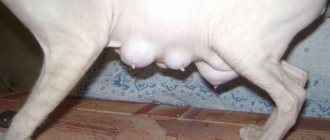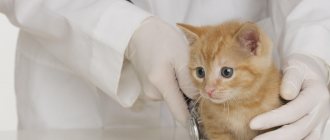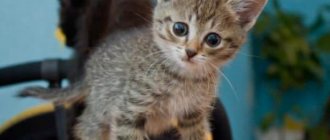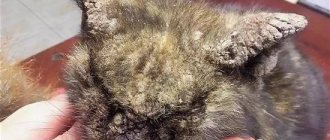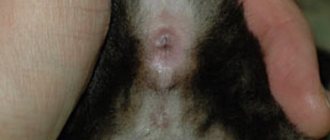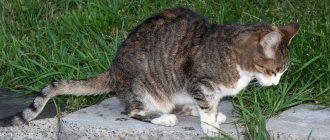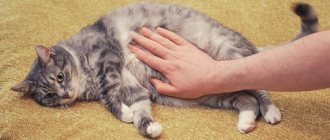Alena Igorevna Goncharenko
veterinarian Petstory
Mastitis in cats is a disease in which inflammation of the mammary gland occurs. This disease is mainly typical for young cats that have recently given birth. This condition requires immediate medical attention due to the fact that both the cat itself and its kittens can suffer.
Lactation mastitis
Lactation mastitis develops in a nursing cat. The mammary glands become so inflamed that they swell to enormous sizes. The cause of this mastitis is stagnation of breast milk, as well as various infections.
If lactation mastitis occurs, you must immediately express milk to prevent the spread of infection. The multiplying bacteria encourage the fermentation process in breast milk.
- As a result, the epithelium is damaged, which interferes with the outflow of fluid.
- This can lead to damage to the lymph nodes and veins.
- Non-lactation mastitis is a rare phenomenon that is not associated with breastfeeding and milk production.
- Its cause is immunodeficiency, as well as injuries to the mammary glands and skin diseases.
- Non-lactation mastitis is easier and is treated faster than lactation mastitis.
How to express milk?
To effectively treat mastitis, it is necessary to prevent stagnation of milk. Along with milk, foreign bacteria are also eliminated. If it has been recommended to remove the kittens from the cat or if they cannot cope with the volume of milk, it is necessary to express it.
- Wash your hands thoroughly.
- If the cat is very active, you will need the help of another person to restrain it. The cat can be placed on your lap with its back to you, or fixed on a flat surface on its side. You can use blankets or towels to cover your cat to prevent injury from claws and teeth.
- Carry out a gentle massage of the mammary glands. It is necessary to do this without obvious effort, but try to knead the dense slices.
- Grasp the mammary gland with your index finger and thumb and gently squeeze until drops of milk appear.
- If it is difficult to let milk out this way, you should not use physical force. It is worth contacting your doctor and clarifying whether you are doing everything correctly.
You can also use a breast pump for women to express milk during mastitis, but its power may be too powerful for cats. Then you should make a breast pump yourself. To do this you will need a 20ml syringe. It is necessary to cut off its upper part (the one where the needle is attached) with a knife. Burn the cut edges over a fire so that they do not scratch the cat's skin. Next, you need to lean the cut part against the cat’s mammary gland and pull the piston so that a vacuum is formed. If you did everything correctly, milk will begin to be sucked into the syringe.
Serous and catarrhal
One form of the disease is serous mastitis, which leads to swelling of the glands and an increase in their temperature. The nipples secrete a white-yellow fluid.
During palpation, the animal does not feel pain, which allows for a high-quality examination. The disease is characterized by redness of the skin.
- Catarrhal mastitis affects only the inner lining of the mammary glands.
- The clinical picture is the same as for serous mastitis.
- A large number of white flakes appear in the milk, which clog the ducts of the glands, which leads to stagnation of milk.
- This background is favorable for pathogenic microflora. Milk gives off an unpleasant odor.
Mastitis in a nursing cat: how to treat it at home
If the disease is just beginning to develop, then the first thing to do is to express some milk from the swollen mammary gland. This will reduce discomfort. If the cat continues to breastfeed the kitten or kittens, then they need to be isolated so that the babies do not continue to become infected through milk. After the kittens are weaned, treatment can begin.
So, how to help a nursing cat:
- insulate her resting place;
- provide nutritious and high-calorie feeding;
- there should always be clean water;
- warm lotions made from a mixture of chamomile and sage;
- gentle massage of the sore breast using camphor oil;
- expressing milk.
One of the main points of home treatment is to provide sick cats with food enriched with vitamins and nutrients. In addition to all of the above, you can also apply a cabbage leaf to cool the affected mammary gland.
Hemorrhagic and gangrenous mastitis
The hemorrhagic form of the disease is a complication of serous and catarrhal mastitis. Characterized by redness of the breast area.
- Spots may appear as this form causes hemorrhages and bleeding.
- The disease is accompanied by pain, fever, and tissue swelling.
- The cat's condition is depressed. This is the most dangerous form of mastitis.
Gangrenous mastitis develops in an advanced stage of necrosis. The skin becomes blue or brown. Bleeding ulcers form if the animal’s immunity is weakened.
Phlegmonous and fibrinous form
The phlegmonous form is a purulent mastitis that affects adipose and connective tissue. The skin condition worsens, the temperature rises, and loss of consciousness may occur. If help is not provided in time, the cat will die.
Fibrinous mastitis is accompanied by blockage of the ducts. Symptoms: Fever, intoxication, apathy, enlarged lymph nodes and mammary glands. When you feel the inflamed areas, you can hear sounds reminiscent of crunching.
Symptoms
If signs of mastitis are detected early, the prognosis for treatment is favorable, but it is quite difficult to notice the symptoms. This is due to the fact that the cat has thick fur, and some pets do not allow you to examine and palpate the belly at all. Regular assessment of the condition of the mammary glands is necessary to detect the disease in the early stages. The following symptoms indicate the presence of inflammation:
- The belly in the nipple area is red;
- There are swellings around them;
- Local increase in temperature in the abdominal area;
- When palpating the nipple, compactions are felt;
- The cat reacts painfully to touching its stomach;
- The cat constantly licks the sore spot;
- When you try to express milk from the gland, a thick, cheesy mass is released.
Further, the manifestations of the disease worsen, leading to the development of more serious symptoms:
- The cat is depressed, meows, refuses food;
- The nipple greatly increases in size, becomes hard and painful;
- Body temperature rises;
- Purulent exudate or blood is released from the nipple;
- Abscesses may appear at the site of inflammation.
Purulent mastitis
With purulent mastitis, milk completely disappears. The mammary glands are enlarged, swollen with elevated temperature. The skin is red. Pus and blood are released from the inflamed nipples.
- The areas affected by mastitis are hard and painful.
- After a while, general symptoms appear in the form of elevated body temperature and intoxication.
- The cat is apathetic and seeks solitude.
- In most cases, the disease enters the chronic stage.
The abscess form is a severe type of purulent mastitis, when capsules filled with pus appear inside the gland. If they rupture, the cat dies from blood poisoning.
Types of mastitis
Lactational
Lactation mastitis develops soon after birth, while feeding kittens. At this time, the mammary gland is in the phase of its most active functioning. A large number of cavities appear in the mammary gland, which are filled with milk. These cavities are surrounded by fatty tissue. The vascular network is actively growing. All this is a favorable environment for the development of pathogenic microflora. Lactostasis, that is, milk stagnation, also contributes to the development of mastitis. For some reason (few kittens, a lot of milk) milk is not evacuated from the mammary gland quickly enough and stagnates. In such milk the risk of developing foreign infection also increases. Bacterial waste products can lead to fermentation of milk and the formation of clots. These clots can block the milk passages and lead to even greater congestion.
Non-lactational
This form of mastitis occurs in non-pregnant cats. The cause may be injuries in the mammary gland, the development of deep infection of the skin, fatty tissue and other nearby tissues, or the use of hormonal drugs.
Photo of mastitis in a cat
Spicy
It manifests itself with clear clinical symptoms: changes in skin color on the mammary gland, pain, swelling, and increased local temperature. The cat may be depressed or not show symptoms of illness. The milk may be red-brown, yellow-green, or remain white.
Chronic
Often the only symptom of chronic mastitis may be the kittens' reluctance to suckle from their mother. The cat may not show any signs of anxiety.
Catarrhal
If you palpate the mammary glands, you can find small lumps. After feeding the kittens or expressing milk, these balls disappear on their own. This course does not cause pain, high body temperature or other changes in cats. The main reason lies in stagnation of milk. This condition can also be called mastopathy.
Serous
The mammary gland becomes enlarged, swollen, and dense. During palpation, the cat may express painful sensations, and an increase in local temperature may be noted. If you try to express milk, a clear liquid will come out first, followed by milk. Milk may contain flaky inclusions.
Fibrinous
The gland is even more enlarged in volume, very dense. When palpated, the cat expresses serious dissatisfaction; sounds resembling crunching can be heard. With this sound, fibrin films that surrounded the mammary gland ducts and glandular tissue are destroyed. An increase in the size of the lymph nodes and an increase in overall body temperature can be noted. Along with the milk, flakes and films are released.
Hemorrhagic
This form of mastitis is characterized by hemorrhages in the breast tissue and adjacent tissue. The mammary gland is enlarged and painful. The milk turns pink or red and may contain blood clots.
Purulent
The cat's mammary gland is extremely painful and very dense. The skin may take on a pink or red tint. During palpation, the cat shows strong dissatisfaction. Purulent discharge from the nipples with a characteristic odor can be noted. Lymph nodes may be enlarged. The cat's general health may be unsatisfactory, she may be lethargic and refuse to eat.
Abscessing
Occurs in the absence of treatment for purulent mastitis. Cavities form inside the mammary gland and are filled with pus. Breast tissue begins to melt due to bacterial activity.
Gangrenous
This type of mastitis develops if anaerobic bacteria join the pathogenic microflora. They very quickly destroy mammary gland tissue and cause necrosis. You may notice a foul odor and a change in skin color to brown or black. Inflammation and infection spread to the tissue surrounding the mammary gland. If left untreated, this form of mastitis will cause serious complications to the cat and may die from sepsis.
Causes of the disease
There are many reasons for the development of mastitis.
The main ones are:
- Unremoved milk after kittens are weaned from the cat. Experts recommend picking up babies no earlier than two months of age. It is advisable to express the milk so that stagnation does not form, leading to mastitis;
- Hypothermia of the glands due to prolonged exposure to the street during the cold season, running air conditioning or drafts at home. Cats are very sensitive to drafts and temperature changes;
- All nipples are not involved in the feeding process;
- The birth was performed by caesarean section. After surgery, the cat cannot feed the kittens breast milk, which leads to stagnation;
- Injury to the mammary glands: scratches, baby bites, cracks;
- Immunodeficiency to which cats are susceptible. Against the background of weak immunity, various diseases can develop that complicate mastitis;
- Sterilization with complete removal of the uterus.
Causes of pathology
The causes of mastitis are:
- injuries to the nipples and mammary glands, burns, frostbite;
- diseases of the reproductive system;
- complications during the postpartum period: endometritis - inflammation of the uterine mucosa;
- pyometra - accumulation of purulent exudate in the uterine cavity;
- false pregnancy;
- excess milk production;
- keeping in a cold room;
Taking hormonal drugs to suppress sexual behavior can cause mastitis
Predisposing factors
Predisposing factors to the development of mastitis are:
- heredity - the tendency to inflammation of the mammary glands can be inherited;
- immunodeficiency conditions, for example, helminthic infestations;
- unbalanced cat nutrition;
- the presence of foci of chronic infection;
- previously suffered mastitis;
- first pregnancy in a cat - during the first, especially early pregnancies, the mammary gland may not have time to complete its formation;
- comorbidities such as diabetes or obesity;
- mastopathy.
Thus, mastitis can appear in nulliparous cats as a result of taking hormonal drugs or false pregnancy; it can occur even in a sterilized pet if her ovaries were left during surgery.
Video: mastitis in pets
Diagnosis and complications
As the disease progresses, symptoms become apparent. In a veterinary clinic, to determine the form and degree of mastitis, they do: a general blood test, collection of biological material, and ultrasound. After which a specific treatment is prescribed.
Mastitis in animals is very rarely accompanied by complications. Especially if you go to a veterinary clinic for timely help.
Types of complications:
- Infection of neighboring organs;
- Damage to the heart or brain;
- The appearance of purulent formations throughout the body—sepsis;
- Painful or toxic shock;
- Development of breast tumors.
Methods for treating mastitis
Treatment of mastitis in cats consists of drug therapy and, in advanced cases, surgery.
- Before going to the clinic, you can provide first aid to your cat: Reduce the animal’s fluid intake and express milk.
- If there are cracks in the nipples, then you can’t express milk, just like you can’t feed babies.
- After the specialist has determined the form and extent of the disease, he prescribes injections to the cat for mastitis, which relieve inflammation with Mastomethrin, Calcium gluconate or Travmatin.
Also, diuretics and drugs to strengthen the immune system are prescribed. Advanced disease is treated with Novocaine, antibiotics and antifungal drugs. The duration of treatment depends on the severity of the disease and ranges from five days to a month. Surgery is prescribed for abscess and severe tissue damage.
As an aid, you can use a cabbage leaf, which is applied to the inflamed areas. Pre-beat the sheet.
- You can make a compress from a decoction of chamomile, oak bark and other antiseptic herbs.
- Sage decoction is used to reduce lactation. Rubbing in special ointments or oils, such as camphor or linseed, will help speed up recovery.
- Treating mastitis in a cat at home is possible only after consulting a veterinarian.
- Since treatment at home can be carried out in the early stages of a mild form of the disease.
During treatment, it is important to dose the cat’s water intake, isolate the kittens from the mother cat, and put on a blanket that will protect them from licking and attempts to feed the cubs.
When is an urgent need to contact a veterinarian?
Unfortunately, it is not always possible to catch mastitis at an early stage, and in the vast majority of cases this is due to the rapid development of the inflammatory process, as well as the fact that many nursing cats do not allow examination of their abdomen and mammary glands.
An urgent visit to the clinic is necessary if:
- increased cat body temperature;
- signs of intoxication appear: lethargy;
- thirst;
- lack of appetite;
- general oppression, apathy;
- is a surgical pathology;
If the cat’s temperature rises and the cat’s well-being becomes unwell, self-medication is unacceptable.
Prevention
Prevention of mastitis is very important for stylized cats and lactating females, since advanced mastitis in a cat can lead to serious consequences, including the death of the animal.
As preventive measures, veterinarians advise:
- Limit the consumption of fluids and foods that stimulate lactation;
- Treat the nipples of a nursing cat with decoctions of antiseptic herbs;
- Timely vaccinate the cat and carry out deworming;
- Clean the room and clean the cat's bedding as often as possible;
- Inspect the nipples of a nursing cat; if alarming symptoms appear, immediately contact a specialist.
The majority of deaths are caused by attempts at self-medication by the owners of their pets.
Prevention of mastitis
Of course, mastitis, like any disease, is easier to prevent than to treat. Provide your pet with proper care, avoid hypothermia and injury. Give hormonal medications to your animal with caution and always consult a doctor about their use.
Carry out timely treatment against parasites, especially before pregnancy and childbirth. In a nursing cat, try to prevent congestion in one breast; at first, watch the babies so that they are applied to each nipple in turn for uniform emptying of the glands.
To prevent purulent mastitis, regularly wash or change the diaper where the cat and kittens are. Monitor the condition of each kitten’s claws and, if necessary, even trim the scratches so that the babies do not scratch the delicate skin near the mother cat’s nipples.
If scratches or cracks appear, wipe the skin with herbal decoctions and use special ointments to prevent infection. Pay enough attention to disease prevention and careful care of the animal.


